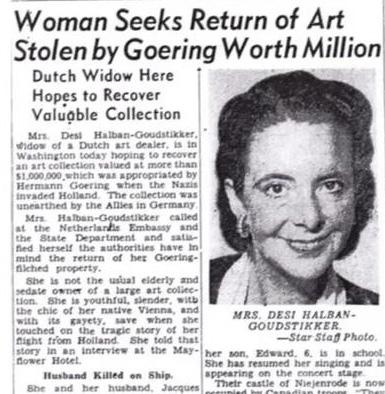T
Will the Lost Museum …
he journalist Hector Feliciano published a book first in French in 1995 and then in English in 1997 called The Lost Museum in which he called attention to the collections in many countries of unclaimed art that had been looted by the Nazis and their allies, collections that had been recovered by the United States military forces and others that after World War II had been sent back to the countries from which they had been taken but had never been distributed by those countries’ governments to the original owners or their heirs. Instead they had been kept in those governments’ museums. It is surprising how many such artworks and other cultural property known to have been looted in the Holocaust remain to this day in the hands of governments throughout the world. By “unclaimed ‘heirless’ looted art” is meant not only paintings and sculptures but also religious ceremonial objects, books and WESLEY FISHER manuscripts that have been identified or presumed to be items looted from their Jewish owners by the Nazis, their allies, or collaborators for which no heirs have been located to date. It is rare for an object to be truly “heirless.” Rather the term is used as a way of characterizing unclaimed property in the wake of the Shoah, in the wake of genocide. In the West, collections of unclaimed and heirless looted art came to be as a result of the policies of the United States, the United Kingdom, and France whereby items for which the original owners could not be immediately identified were repatriated to the capitals of the respective
In 2003, the American Alliance of Museums established the Nazi-Era Provenance Internet Portal (NEPIP), a central registry of objects in U.S. museums that could have changed hands in Europe during the Nazi era, 1933-1945. Currently 179 museums are participating, which includes 20 museums with Judaica collections, and an additional 32 museums that report not to hold any relevant objects. Currently 29,864 objects are listed. There is more updated information available on various museum websites.
At a conference in 2018 in Israel, the Jerusalem Declaration was endorsed that proposed that unclaimed “heirless” objects be made available on loan for exhibitions around the world. Hopefully this will transpire, and the “lost museum” will become the “found museum.” countries from which they had been taken. The U.S. Military referred to this as an “external restitution” policy. The Cold War was beginning, and it was important to end problems that remained from World War II as soon as possible. However, the Jews of the world considered it morally inadmissible and a legal problem for non-Jewish organizations or people to hold on to heirless or unclaimed artwork and cultural objects taken from their Jewish owners by way of plunder, confiscation, seizure, or forced sale. Although
after pogroms and expulsions the Jews of the world had usually moved on, the enormity of the Nazi theft and murder was such that this time they stood their ground and insisted on as full restitution as possible. In November 1947 U.S. Military Law 59 was enacted in the American Zone of Occupied Germany. It called for the restoration of identifiable property that had been seized on racial, political, or religious grounds, and also established the principle that a “successor organization” would have the right to claim the assets of those who had perished,
and to use the proceeds of the sales of the assets for the relief and rehabilitation of survivors. In June of 1948 the U.S. Military Government in Germany authorized the Jewish Restitution Successor Organization (JRSO) to recover unclaimed Jewish property and the property of dissolved Jewish communities and associations in the American Zone. Similar organizations were formed in the British and French Zones. The Jewish organizations that formed the JRSO were from not only the United States but also from the rest of the world. A specialized organization, Jewish Cultural Reconstruction (JCR), that had begun as a scholarly initiative eventually was established in 1947 to redistribute heirless Jewish cultural property in the American zone. In the East, the Soviet Union followed a different path, that of “compensatory restitution” for all the cultural property that Nazi Germany had plundered or destroyed. In 1942 Igor Grabar, the principal art historian of the Soviet Union, convinced Josef Stalin that lists should be drawn up of artworks to be taken for such compensation. These lists were mostly of Italian artworks, but by the time the Red Army reached Berlin, Italy was no longer in the war, and the Soviet Trophy Brigades charged with taking artworks and other cultural property back to Moscow began to take whatever was in their path, so millions of objects were brought to the Soviet Union. While some of these were returned to the communist countries of Eastern Europe in the 1950s and 1960s, millions of objects remain in the former Soviet Union. Issues of looted art were for decades after the war backburnered in view of the need for survivors to be resettled and the need to cope with the sheer magnitude of the destruction. With the fall of communism and the opening of archives in
Left: Offenbach, Germany, some of the six hundred Torah scrolls that were brought to the Offenbach Archival Depot from all over the American-administered area of Germany, 1946. Second from left: In a cellar in Frankfurt, Germany, Chaplain Samuel Blinder examines Sefer Torahs stolen from across Europe. Photo, National Archives. Third from left: Torah breast plates. Right: Chanukah Candelabra confiscated by Nazis. USHMM courtesy of S. J. Pomrenze
14
HOLOCAUST REMEMBERED |
APRIL 27, 2022
|
Supplement created and paid for by the SOUTH CAROLINA COUNCIL ON THE HOLOCAUST
B




















